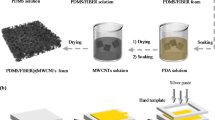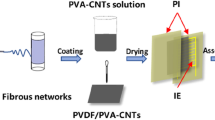Abstract
The research on flexible pressure sensors has drawn widespread attention in recent years, especially in the fields of health care and intelligent robots. In practical applications, the sensitivity of sensors directly affects the precision and integrity of weak pressure signals. Here, a pressure sensor with high sensitivity and a wide measurement range composed of porous fiber paper and 3D patterned electrodes is proposed. Multi-walled carbon nanotubes with excellent conductivity were evenly sprayed on the fiber paper to form the natural spatial conducting networks, while the copper-deposited polydimethylsiloxane films with micro-pyramids array were used as electrodes and flexible substrates. Increased conducting paths between electrodes and fibers can be obtained when high-density micro-pyramids fall into the porous structures of the fiber paper under external pressure, thereby promoting the pressure sensor to show an ultra-high sensitivity of 17.65 kPa−1 in the pressure range of 0–2 kPa, 16 times that of the device without patterned electrodes. Besides, the sensor retains a high sensitivity of 2.06 kPa−1 in an ultra-wide measurement range of 150 kPa. Moreover, the sensor can detect various physiological signals, including pulse and voice, while attached to the human skin. This work provides a novel strategy to significantly improve the sensitivity and measurement range of flexible pressure sensors, as well as demonstrates attractive applications in physiological signal monitoring.
Similar content being viewed by others
References
Chen S, Qi J, Fan S, et al. Flexible wearable sensors for cardiovascular health monitoring. Adv Healthc Mater, 2021, 2021: 10
Guo Y, Wei X, Gao S, et al. Recent advances in carbon material-based multifunctional sensors and their applications in electronic skin systems. Adv Funct Mater, 2021, 2021: 31
Shao J Y, Chen X L, Li X M, et al. Nanoimprint lithography for the manufacturing of flexible electronics. Sci China Tech Sci, 2019, 2019: 62–175
Li S, Xiao X, Hu J, et al. Recent advances of carbon-based flexible strain sensors in physiological signal monitoring. ACS Appl Electron Mater, 2020, 2020: 2–2282
Sun T, Jiang Y D, Duan Z H, et al. Wearable and washable textile-based strain sensors via a single-step, environment-friendly method. Sci China Tech Sci, 2021, 2021: 64–441
Jiang S, Yu J, Xiao Y, et al. Ultrawide sensing range and highly sensitive flexible pressure sensor based on a percolative thin film with a knoll-like microstructured surface. ACS Appl Mater Interfaces, 2019, 2019: 11–20500
Li T, Chen L, Yang X, et al. A flexible pressure sensor based on an MXene-textile network structure. J Mater Chem C, 2019, 2019: 7–1022
Chen X, Zeng Q, Shao J, et al. Channel-crack-designed suspended sensing membrane as a fully flexible vibration sensor with high sensitivity and dynamic range. ACS Appl Mater Interfaces, 2021, 2021: 13–34637
Kim H J, Kim Y J. High performance flexible piezoelectric pressure sensor based on CNTs-doped 0–3 ceramic-epoxy nanocomposites. Mater Des, 2018, 2018: 151–133
Jiang J, Tu S, Fu R, et al. Flexible piezoelectric pressure tactile sensor based on electrospun BaTiO3/Poly(vinylidene fluoride) nanocomposite membrane. ACS Appl Mater Interfaces, 2020, 2020: 12–33989
Chamankar N, Khajavi R, Yousefi A A, et al. A flexible piezoelectric pressure sensor based on PVDF nanocomposite fibers doped with PZT particles for energy harvesting applications. Ceram Int, 2020, 2020: 46–19669
Chen X, Shao J, Tian H, et al. Scalable imprinting of flexible multiplexed sensor arrays with distributed piezoelectricity-enhanced micropillars for dynamic tactile sensing. Adv Mater Technol, 2020, 2020: 5
Cheng Y, Wu D, Hao S, et al. Highly stretchable triboelectric tactile sensor for electronic skin. Nano Energy, 2019, 2019: 64
Ning C, Dong K, Cheng R, et al. Flexible and stretchable fiber-shaped triboelectric nanogenerators for biomechanical monitoring and human-interactive sensing. Adv Funct Mater, 2021, 2021: 31
Wang H L, Kuang S Y, Li H Y, et al. Large-area integrated triboelectric sensor array for wireless static and dynamic pressure detection and mapping. Small, 2020, 2020: 16
Du Y, Wang X, Dai X, et al. Ultraflexible, highly efficient electromagnetic interference shielding, and self-healable triboelectric nanogenerator based on Ti3C2T MXene for self-powered wearable electronics. J Mater Sci Tech, 2022, 2022: 100–1
Uzun S, Seyedin S, Stoltzfus A L, et al. Knittable and washable multifunctional MXene-coated cellulose yarns. Adv Funct Mater, 2019, 2019: 29
Zhang Y, Liu S, Miao Y, et al. Highly stretchable and sensitive pressure sensor array based on icicle-shaped liquid metal film electrodes. ACS Appl Mater Interfaces, 2020, 2020: 12–27961
Lapčinskis L, Linarts A, Knite M, et al. Solid-state supercapacitor application for pressure sensing. Appl Surf Sci, 2019, 2019: 474–91
Luo Y, Shao J, Chen S, et al. Flexible capacitive pressure sensor enhanced by tilted micropillar arrays. ACS Appl Mater Interfaces, 2019, 2019: 11–17796
Zheng Q, Lee J, Shen X, et al. Graphene-based wearable piezoresistive physical sensors. Mater Today, 2020, 2020: 36–158
Qin J, Yin L J, Hao Y N, et al. Flexible and stretchable capacitive sensors with different microstructures. Adv Mater, 2021, 2021: 33
Chang J Y, Zhang Z X, Jia F, et al. Ionic conductive hydrogels toughened by latex particles for strain sensors. Sci China Tech Sci, 2020, 2020: 64–827
Huang Y H, Xiang Y, Ren W T, et al. Enhancing the sensitivity of crack-based strain sensor assembled by functionalized graphene for human motion detection. Sci China Tech Sci, 2021, 2021: 64–1805
Fortunato M, Bellagamba I, Tamburrano A, et al. Flexible ecoflex(R)/graphene nanoplatelet foams for highly sensitive low-pressure sensors. Sensors, 2020, 2020: 20
Tai H, Duan Z, Wang Y, et al. Paper-based sensors for gas, humidity, and strain detections: A review. ACS Appl Mater Interfaces, 2020, 2020: 12–31037
Schlicke H, Kunze S, Rebber M, et al. Cross-linked gold nanoparticle composite membranes as highly sensitive pressure sensors. Adv Funct Mater, 2020, 2020: 30
Jeong H, Noh Y, Ko S H, et al. Flexible resistive pressure sensor with silver nanowire networks embedded in polymer using natural formation of air gap. Compos Sci Tech, 2019, 2019: 174–50
Hao D P, Yang R X, Yi N, et al. Highly sensitive piezoresistive pressure sensors based on laser-induced graphene with molybdenum disulfide nanoparticles. Sci China Tech Sci, 2021, 2021: 64–2408
Sun X, Sun J, Li T, et al. Flexible tactile electronic skin sensor with 3D force detection based on porous CNTs/PDMS nanocomposites. Nano-Micro Lett, 2019, 2019: 11
Bystrzejewski M, Huczko A, Lange H, et al. Dispersion and diameter separation of multi-wall carbon nanotubes in aqueous solutions. J Colloid Interface Sci, 2010, 2010: 345–138
Wang J, Zhang C, Chen D, et al. Fabrication of a sensitive strain and pressure sensor from gold nanoparticle-assembled 3D-interconnected graphene microchannel-embedded PDMS. ACS Appl Mater Interfaces, 2020, 2020: 12–51854
Xu S, Li X, Sui G, et al. Plasma modification of PU foam for piezoresistive sensor with high sensitivity, mechanical properties and long-term stability. Chem Eng J, 2020, 2020: 381
Zheng Y, Yin R, Zhao Y, et al. Conductive MXene/cotton fabric based pressure sensor with both high sensitivity and wide sensing range for human motion detection and E-skin. Chem Eng J, 2021, 2021: 420
Li Y, Samad Y A, Taha T, et al. Highly flexible strain sensor from tissue paper for wearable electronics. ACS Sustain Chem Eng, 2016, 4: 4288–4295
Liu Y Q, Zhang Y L, Jiao Z Z, et al. Directly drawing high-performance capacitive sensors on copying tissues. Nanoscale, 2018, 2018: 10–17002
Long Y, He P, Xu R, et al. Molybdenum-carbide-graphene composites for paper-based strain and acoustic pressure sensors. Carbon, 2020, 2020: 157–594
Tao L Q, Zhang K N, Tian H, et al. Graphene-paper pressure sensor for detecting human motions. ACS Nano, 2017, 2017: 11–8790
Zhu Z, Zhang H, Xia K, et al. Hand-drawn variable resistor and strain sensor on paper. Microelectron Eng, 2018, 2018: 191–72
Wang D, Li D, Zhao M, et al. Multifunctional wearable smart device based on conductive reduced graphene oxide/polyester fabric. Appl Surf Sci, 2018, 2018: 454–218
Cheng Y, Ma Y, Li L, et al. Bioinspired microspines for a high-performance spray Ti3C2Tx MXene-based piezoresistive sensor. ACS Nano, 2020, 2020: 14–2145
Gao Y, Yan C, Huang H, et al. Microchannel-confined MXene based flexible piezoresistive multifunctional micro-force sensor. Adv Funct Mater, 2020, 2020: 30
Ma Y, Liu N, Li L, et al. A highly flexible and sensitive piezoresistive sensor based on MXene with greatly changed interlayer distances. Nat Commun, 2017, 2017: 8
Qin R, Hu M, Li X, et al. A highly sensitive piezoresistive sensor based on MXenes and polyvinyl butyral with a wide detection limit and low power consumption. Nanoscale, 2020, 2020: 12–17715
Wang Z, Wang S, Zeng J, et al. High sensitivity, wearable, piezoresistive pressure sensors based on irregular microhump structures and its applications in body motion sensing. Small, 2016, 2016: 12–3827
Yu J, Hou X, Cui M, et al. Flexible PDMS-based triboelectric nanogenerator for instantaneous force sensing and human joint movement monitoring. Sci China Mater, 2019, 2019: 62–1423
Yu J, Hou X, He J, et al. Ultra-flexible and high-sensitive triboelectric nanogenerator as electronic skin for self-powered human physiological signal monitoring. Nano Energy, 2020, 2020: 69
Jiang D, Zhang J, Qin S, et al. Superelastic Ti3C2Tx MXene-based hybrid aerogels for compression-resilient devices. ACS Nano, 2021, 2021: 15–5000
Sencadas V, Tawk C, Alici G. Environmentally friendly and biodegradable ultrasensitive piezoresistive sensors for wearable electronics applications. ACS Appl Mater Interfaces, 2020, 2020: 12–8761
Tang Z, Jia S, Zhou C, et al. 3D printing of highly sensitive and large-measurement-range flexible pressure sensors with a positive piezoresistive effect. ACS Appl Mater Interfaces, 2020, 2020: 12–28669
Ma Z, Wang W, Yu D. Highly sensitive and flexible pressure sensor prepared by simple printing used for micro motion detection. Adv Mater Interfaces, 2020, 2020: 7
Gong S, Schwalb W, Wang Y, et al. A wearable and highly sensitive pressure sensor with ultrathin gold nanowires. Nat Commun, 2014, 2014: 5
Zhao P, Zhang R, Tong Y, et al. All-paper, all-organic, cuttable, and foldable pressure sensor with tuneable conductivity polypyrrole. Adv Electron Mater, 2020, 2020: 6
Chen S, Song Y, Xu F. Flexible and highly sensitive resistive pressure sensor based on carbonized crepe paper with corrugated structure. ACS Appl Mater Interfaces, 2018, 2018: 10–34646
Peltokangas M, Suominen V, Vakhitov D, et al. The effect of percutaneous transluminal angioplasty of superficial femoral artery on pulse wave features. Comput Biol Med, 2018, 2018: 96–274
Kohara K, Tabara Y, Oshiumi A, et al. Radial augmentation index: A useful and easily obtainable parameter for vascular aging. Am J Hypertension, 2005, 2005: 18–11
Author information
Authors and Affiliations
Corresponding author
Additional information
This work was supported by the National Key R&D Program of China (Grant Nos. 2019YFE0120300, 2019YFF0301802), National Natural Science Foundation of China (Grant Nos. 52175554, 62101513, 51975542), Natural Science Foundation of Shanxi Province (Grant No. 201801D121152), Shanxi “1331 Project” Key Subject Construction (Grant No. 1331KSC), National Defense Fundamental Research Project, and Research Project Supported by ShanXi Scholarship Council of China (Grant No. 2020-109).
Supporting Information
The supporting information is available online at http://tech.scichina.com and http://link.springer.com. The supporting materials are published as submitted, without typesetting or editing. The responsibility for scientific accuracy and content remains entirely with the authors.
Electronic Supplementary Material
Rights and permissions
About this article
Cite this article
Hou, X., Zhong, J., He, J. et al. Porous fiber paper and 3D patterned electrodes composed high-sensitivity flexible piezoresistive sensor for physiological signal monitoring. Sci. China Technol. Sci. 65, 1169–1178 (2022). https://doi.org/10.1007/s11431-021-1993-9
Received:
Accepted:
Published:
Issue Date:
DOI: https://doi.org/10.1007/s11431-021-1993-9




